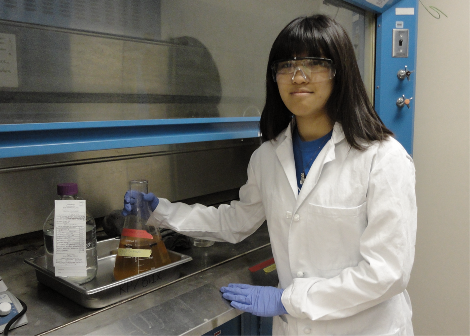Team:Caltech/Biosafety
From 2011.igem.org
| Line 1: | Line 1: | ||
{{Team:Caltech/templateheader| | {{Team:Caltech/templateheader| | ||
Content= | Content= | ||
| - | + | __TOC__<br/> | |
[[File:Small_Safety.jpg|right]] | [[File:Small_Safety.jpg|right]] | ||
===Researcher Safety=== | ===Researcher Safety=== | ||
Revision as of 23:57, 13 July 2011
|
Project |
Researcher SafetyWhile most of our project is in lab strains of E. coli, (NIH Risk Group 1) we are culturing organisms from environmental samples that are able to survive in minimal media containing one of the four endocrine disrupting compounds (EDCs) we are hoping to degrade. Past studies have found Pseudomonas species (Kang, Katayama et al. 2006) and Sphingomonas species (Sasaki, Maki et al. 2005) capable of degrading bisphenol A. These genera can be found in NIH Risk Groups 2 and 3. Due to immediately culturing in minimal media, it is unlikely that we will culture any significantly pathogenic organisms from the LA River, according to the Caltech Safety Office. We are working with endocrine disrupting compounds. These affect the endocrine system by competing with hormones to bind nuclear receptors, and can act as agonists or antagonists affecting the transcription of the many genes controlled by the presence or absence of hormones. We have chosen to focus on those that can bind to the estrogen receptor, as these particular endocrine disruptors have been shown to cause higher prevalence of intersex fish near sources of EDC pollution (Wise, O'Brien et al. 2011). The four chemicals we are focusing on are: bisphenol A, nonylphenol, 17a-ethynylestradiol, and 4,4’-DDT. These EDCs are harmful to human health. They affect the reproductive system by their nature as endocrine disruptors. 4,4' DDT and 17a-ethynylestradiol are known carcinogens. 17a-ethynylestradiol is a known teratogen (MSDS). We take care to use small amounts and avoid exposure by contact or inhalation. When performing the screen described in Kiyohara et al., 1982, which requires the water-insoluble EDCs to be dissolved in a volatile solvent and sprayed on plates, we will work in the hood with respiratory equipment as required. The safety office also recommends an alternative where we pour on plates rather than spray to minimize inhalation risk. We are doing further research for safe application before attempting this procedure. Public SafetyEnvironmental SafetyThese EDCs are particularly toxic to aquatic life. We avoid allowing any amount of these chemicals to go down the drain and instead collect waste in a hazardous waste container as described by the Institute’s hazardous waste policies. For field use, our genes must be placed in a chassis that will have direct contact with polluted water. We must try to minimize environmental contamination of both the organism and its recombinant DNA as per NIH guidelines. One common method of in situ bioremediation of ground water, using microorganisms present at the site, is to have wells. One is used to inject a carbon source and electron donor, and a later well is where purified water can be found and tested (Hwang, Wu et al. 2009). This injection allows humans to increase the rate of degradation by the microbe community at the site. This sort of system is invasive and would be best used in sites that require long-term remediation, such as the uranium site in Hwang et al. Because of NIH and EPA guidelines, there have been few field trials for bioremediation using genetically modified organisms. Then first approval of use of genetically modified bacteria in the field was in 2000, by Ripp and al. They used Pseudomonas fluorescens HK44 to degrade naphthalene. It also contained lux, which allowed for visual tracking of the genetically modified organisms (Urgun-Demirtas, Stark et al. 2006). For genetically modified bioremediation to get out of labs and into the field, we need to have some sort of containment system. New BioBricksAs part of our project involves isolating an EDC degradation pathway from environmental samples, we do not yet know if a BioBrick containing this pathway would be safe. It is possible that the pathway’s metabolites are more harmful than the endocrine disruptor is. They may be more potent endocrine disruptors or more toxic to humans and aquatic life. We will determine the metabolites of a degradation pathway using HPLC. We can then look in the literature for any evidence of toxicity or estrogenicity. Biosafety RegulationsInternational: National: Local: We talked to the safety office about our project. They saw no problems with our handling of biological safety since we are working with Level 1 organisms. They noted that the possibility of growing pathological bacteria from our enrichment cultures is low due to immediately diluting in minimal media rather than growing environmental samples up on LB. If we suspect any of the cultured organisms are harmful, we will work with the safety office to implement proper safety procedures. However, we talked to the safety office about some of the possible chemical hazards in our lab. They directed us to dispose of endocrine disrupting compounds as hazardous waste and taught us how to properly label and store the container. We were also instructed to make sure anything containing EDCs is stored in secondary containment. Any solid waste (tubes, etc) should be put in a container or bag and also labeled as hazardous waste. We will place containers containing EDCs in secondary containment as much as possible to avoid researcher exposure or environmental contamination. The team completed safety training including a walkthrough the lab with the lab safety officer before beginning any lab work. We also spent about 3 days with the graduate student mentors learning molecular biology techniques including how do be safe while doing so. Ideas for iGEM SafetyReferences4,4' DDT; MSDS No. 386340; Sigma-Aldrich: St. Louis, MO, April 8, 2011.
|
 "
"

